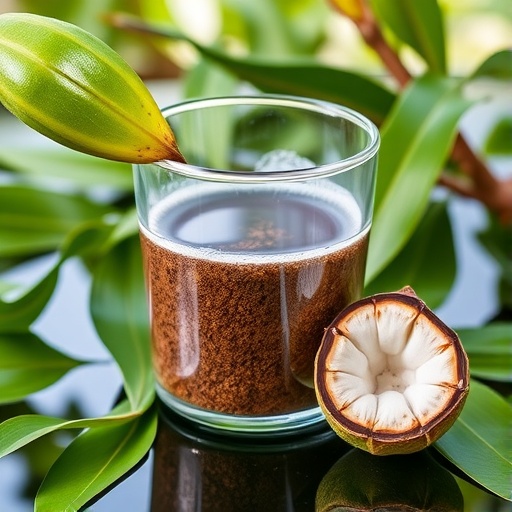In a groundbreaking study, researchers have innovatively harnessed cocoa waste, a byproduct traditionally discarded during the chocolate production process, to create an effective method for lead adsorption in water. This process not only addresses environmental concerns but also presents a sustainable solution to the prevalent issue of water pollution. The research, led by Pinto, S.O., Sampaio, I.C.F., and Dos Anjos, P.N.M., showcases the dual benefit of mitigating waste while simultaneously enhancing water purification technologies.
The study revealed that the fermented solids derived from cocoa waste exhibit remarkable properties for absorbing lead from contaminated water sources. Lead, a heavy metal known for its toxic effects, poses serious health risks, especially in developing regions where industrial effluents often contaminate freshwater resources. The findings from this research emphasize the urgent need for effective and sustainable methods to purify water, particularly in locations where traditional filtration systems may be inadequate.
Fermentation of cocoa waste was carefully analyzed, revealing the optimal conditions for maximizing its lead adsorption capabilities. The researchers explored various fermentation parameters such as temperature, duration, and the specific strains of microorganisms used in the process. This focus on fermentation not only enhances the adsorption efficiency but also enriches the cocoa waste material, transforming it from a nuisance into a valuable resource. The meticulous experimentation associated with this study underscores the importance of process optimization in environmental science.
In practical applications, the fermented cocoa waste could serve as a low-cost alternative to conventional adsorbents, like activated carbon, which can be expensive to produce and may have adverse environmental impacts. By utilizing agricultural byproducts, this method proposes a circular economy model where waste is transformed into a resource, reducing overall industrial waste and promoting sustainability. This innovative approach stands in sharp contrast to traditional waste management methods that often lead to environmental degradation.
The researchers conducted rigorous testing to quantify the lead adsorption capacity of the fermented cocoa waste. The results indicated a strong correlation between the processing conditions and the effectiveness of lead removal from water, showcasing values as high as 95% lead reduction in contaminated samples. This impressive performance highlights the viability of this biowaste-derived material as a feasible component in future water treatment systems aimed at achieving high purification standards.
This work not only addresses immediate environmental issues but also aligns with global initiatives focused on sustainability and resource recovery. As countries strive to meet stricter water quality regulations, the adoption of innovative solutions like fermented cocoa waste could be pivotal. The research team’s findings can catalyze further exploration into other waste materials, encouraging similar studies that may reveal additional sustainable options for environmental remediation.
The potential applications of this technology extend beyond lead adsorption. The chemical makeup of fermented cocoa waste may also harbor properties useful for trapping other heavy metals or contaminants in water. Future research directions could explore the versatility of this biocomposite, assessing its efficacy against a broader spectrum of pollutants, thereby expanding its applicability across various environmental contexts.
Moreover, the study emphasizes the implications of interdisciplinary research, combining principles from agricultural science, environmental science, and biotechnology. Collaborative efforts across these fields will be vital in scaling up this innovation from laboratory settings to real-world applications. Developing cooperative partnerships within academic, industry, and governmental sectors can enhance research agendas aimed at water quality improvement.
The promising results of this study urge immediate attention to policy frameworks governing water resources and industrial waste management. Implementation of findings from such research may prompt regulatory changes facilitating the adoption of biowaste utilization in water treatment processes. Policymakers can leverage emerging technologies and encourage investments in sustainable solutions that align with public health priorities and environmental sustainability goals.
The economic implications are equally significant. Utilizing a waste product like cocoa byproducts for water purification presents an opportunity for economic development in regions heavily reliant on agriculture. By generating value from what would otherwise be discarded, communities can foster local economies while addressing water security challenges. This model of leveraging local resources for collective benefit showcases the potential for sustainable innovation.
Furthermore, community engagement and education become essential components of the successful deployment of this technology. Awareness campaigns focusing on the importance of water quality and the role of innovative solutions could inspire local action. By involving community stakeholders, the transition toward utilizing fermented cocoa waste can be expedited, ultimately fostering a culture of sustainability and environmental stewardship.
In conclusion, the research conducted by Pinto, S.O., Sampaio, I.C.F., and Dos Anjos, P.N.M. serves as a critical step toward revolutionizing approaches to water purification. By transforming cocoa waste into a resource for lead adsorption, the study not only mitigates pollution but also supports sustainable agricultural practices and waste management. The implications of this work extend far beyond the laboratory, offering hope and actionable solutions for addressing the pressing challenge of water contamination globally. As these findings circulate within the scientific community and beyond, they may pave the way for a broader acceptance and integration of waste-derived materials in environmental remediation strategies.
The future looks promising for the intersection of agriculture and environmental science, with innovative studies like this crafting narratives of sustainability, resource optimization, and ecological responsibility. The challenge remains for researchers and practitioners to build upon these foundations, further exploring the depths of waste-reduction technology to forge healthier ecosystems and communities alike.
Subject of Research: Fermented cocoa waste for lead adsorption in water
Article Title: Production and characterization of fermented solid derived from cocoa waste for lead adsorption in water.
Article References:
Pinto, S.O., Sampaio, I.C.F., Dos Anjos, P.N.M. et al. Production and characterization of fermented solid derived from cocoa waste for lead adsorption in water.
Environ Sci Pollut Res (2025). https://doi.org/10.1007/s11356-025-36915-1
Image Credits: AI Generated
DOI:
Keywords: Cocoa waste, lead adsorption, water purification, fermentation, sustainability, environmental science.




